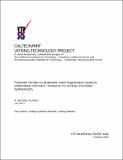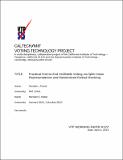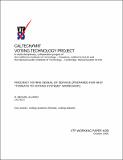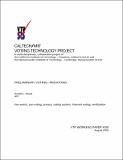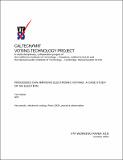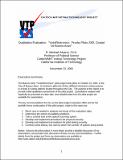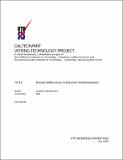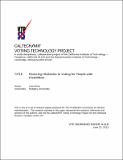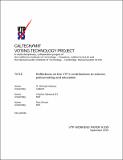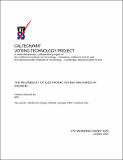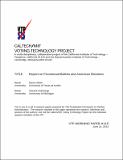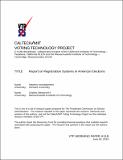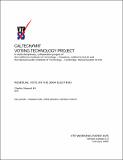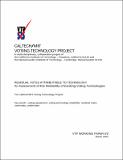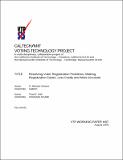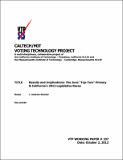Browsing Voting Technology Project by Title
Now showing items 68-87 of 125
-
Potential Threats to Statewide Voter Registration Systems
(Caltech/MIT Voting Technology Project, 2005-10-06)The Help America Vote Act (HAVA), passed in 2002, requires that states implement "...a single, uniform, official, centralized, interactive computerized statewide voter registration list defined, maintained, and administered ... -
Practical End-to-End Verifiable Voting via Split-Value Representations and Randomized Partial Checking
(Caltech/MIT Voting Technology Project, 2014-04-03)We describe how to use Rabin's "split-value" representations, originally developed for use in secure auctions, to efficiently implement end-to-end verifiable voting. We propose a simple and very elegant combination of ... -
Practical Provably Correct Voter Privacy Protecting End-to-End Voting Employing Multiparty Computations and Split Value Representations of Votes
(Caltech/MIT Voting Technology Project, 2014-05-12)Continuing the work of Rabin and Rivest we present another simple and fast method for conducting end to end voting and allowing public verification of correctness of the announced vote tallying results. This method was ... -
Precinct Voting Denial of Service
(Caltech/MIT Voting Technology Project, 2005-10-05)This is a type of threat that has a long history in electoral politics, and can take many forms. The basic approach is that a perpetrator attacks precinct voting, regardless of voting system, on election day in an effort ... -
Preliminary Voting -- Prevoting
(Caltech/MIT Voting Technology Project, 2005-08-06)We introduce the notion of preliminary voting, or pre-voting, wherein a voter deposits—perhaps over the Internet—a preliminary vote or prevote with election authorities at some time before the close of elections. Prevotes ... -
Processes Can Improve Electronic Voting: A Case Study of An Election
(Caltech/MIT Voting Technology Project, 2004-09-07)Across the United States, I have personally watched hundreds of precincts vote since 2001. Most recently, I traveled to Reno/Sparks, Nevada to observe the rollout of the Sequoia Direct record electronic voting systems with ... -
Qualitative Evaluation: "VotoElectronico: Prueba Piloto 2005, Ciudad De Buenos Aires"
(Caltech/MIT Voting Technology Project, 2005-11-22)The Buenos Aires “VotoElectronico” pilot project took place on October 23, 2005, in the City of Buenos Aires. It involved a pilot test of four different electronic voting systems, in at least 43 voting stations located ... -
Racial Differences in Election Administration
(Caltech/MIT Voting Technology Project, 2009-07-25) -
Rational and Pluralistic Approaches to HAVA Implementation
(Caltech/MIT Voting Technology Project, 2005-07)The Help America Vote Act (HAVA) has created a new dynamic for the oversight and implementation of federal elections, requiring states to assume greater control of election processes vis-a-vis their local governments than ... -
the Recruitment and Training of Poll Workers: What We Know from Scholarly Research
(Caltech/MIT Voting Technology Project, 2013-09-06)In every election an army of temporary poll workers must be recruited and trained to both assist the public in exercising the right to vote and to enforce the rules governing the voting process. These poll workers are ... -
Reducing Obstacles to Voting for People with Disabilities
(Caltech/MIT Voting Technology Project, 2013-06-22)The Presidential Commission on Election Administration’s mission includes identifying best practices and making recommendations to promote voting accessibility and improve the experiences of voters with disabilities. This ... -
Reflections on the VTP's contributions to science, policymaking and education
(Caltech/MIT Voting Technology Project, 2010-09)In the immediate wake of the 2000 presidential election, the Caltech/MIT Voting Technology Project was initiated. The initial and primary concern of the VTP at that moment was to understand the problems that arose in the ... -
The Reliability of Electronic Voting Machines in Georgia
(Caltech/MIT Voting Technology Project, 2004-10-08)Following the 2000 presidential election, the state of Georgia instituted the most comprehensive overhaul of voting technology in the country. Georgia’s actions, led by Secretary of State Cathy Cox, were precipitated by ... -
Report on Provisional Ballots and American Elections
(Caltech/MIT Voting Technology Project, 2013-06-21)Both empirical and anecdotal data indicate that the use of provisional ballots in U.S. elections is a mixed bag. On the one hand, providing voters whose eligibility is unclear with an opportunity to cast a provisional ... -
Report on Registration Systems in American Elections
(Caltech/MIT Voting Technology Project, 2013-06-26)Voter registration systems are the backbone of election administration in the United States today. These lists facilitate the operation of elections at the precinct level, communications by election officials and candidates ... -
Research Note on Footnote 24 of the 6th Circuit Hunter Decision
(Caltech/MIT Voting Technology Project, 2011-02-03)The decision issued by the three-judge panel of the 6th Circuit Court of Appeals in the matter of Hunter v. Hamilton County Board of Elections contains a very interesting analysis of problems with Ohio’s law about counting ... -
Residual Vote in the 2004 Election
(Caltech/MIT Voting Technology Project, 2005-02-07)In 2000 Americans learned that their elections are not always run according to the highest standards. This revelation led to two major developments. The first was a flurry of election reform activity at the state and ... -
Residual Votes Attributable to Technology: An Assessment of the Reliability of Existing Voting Equipment
(Caltech/MIT Voting Technology Project, 2001-03-30)American elections are conducted using a hodge-podge of different voting technologies: paper ballots, lever machines, punch cards, optically scanned ballots, and electronic machines. And the technologies we use change ... -
Resolving Voter Registration Problems: Making Registration Easier, Less Costly and More Accurate
(Caltech/MIT Voting Technology Project, 2009-08)The practice of voter registration has a long history in the United States. In 1800, Massachusetts was the first state to impose a voter registration requirement. By Reconstruction, voter registration was used in a handful ... -
Results and Implications: The June "Top-Two" Primary & California's 2012 Legislative Races
(Caltech/MIT Voting Technology Project, 2012-11-02)This report summarizes some basic results of California’s June 2012 “Top-Two” primary. It focuses on legislative offices with multiple districts within the state: California State Assembly, California State Senate, and ...

